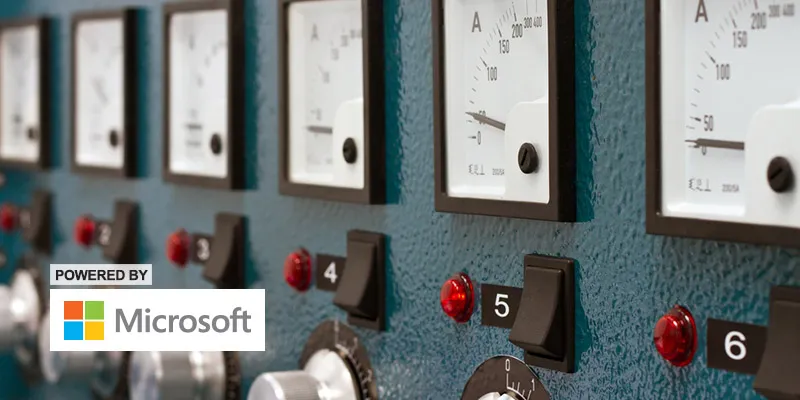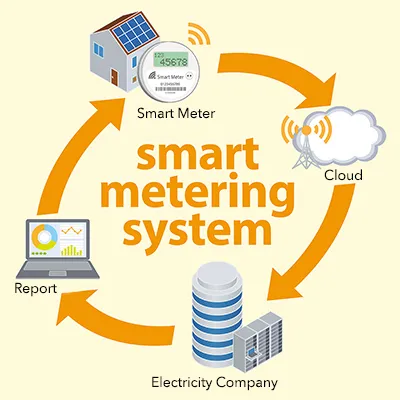Can our electricity meters be as smart as our phones? PowerOneData is making it happen
This article is a part of CloudSparks Series sponsored by Microsoft Azure.
Azure is Microsoft’s cloud platform: a growing collection of integrated services—compute, storage, data, networking, and app—that help you move faster, do more, and save money. This powerful combination of managed and unmanaged services lets you build, deploy, and manage applications any way you like for unmatched productivity. Its enterprise-proven hybrid cloud solutions give you the best of both worlds and can quickly scale up or down to match demand. It’s also easier to build applications that span both on-premises and the cloud. With Azure, data storage, backup, and recovery become more efficient and economical.
----------------------------------------------------------------------------------------------------------------------------------------------------------
In the mobile world, we have moved from feature phones to smartphones quite quickly (in less than a decade). In electricity, too, slowly but surely, the same thing is happening - lots of smart metres are replacing the standard meters.
Not just in India, smart meters are just one part of a global trend to improve the operation of electrical grids and to manage electricity more efficiently, wisely, and with less impact on the environment.
There are plans to install smart metering systems in nearly all areas in the word with projects underway or in planning in such far-flung places as Tajikistan, Zimbabwe, and Peru, often through financing from branches of the World Bank. In India, the Modi government has set a goal of building 100 new smart cities, often as satellites of existing urban centers, to follow the best practices in building modern infrastructure. About 20 smart city projects are targeted to begin construction in 2015 and smart metering is a key component. PowerOneData International is working with several large System Integrators handing these projects to make it possible.

YourStory spoke with Mike McGowan, CTO & MD of PowerOneData International, and got to know where they started and where they are heading. Mike is also the Managing Director for the product development center in Bangalore, India, where he currently resides. He is responsible for both the day-to-day operations in India and for setting the direction for the company’s technology overall. Prad Mohanty is the CEO of PowerOneData International – the company that provides an end-to-end solution for smart metering including hardware and management software.
The current stage of PoweOneData
YourStory learnt that PowerOneData is still in the early stages of product deployment and building revenue; that they spent the last three years developing their products and subjecting them to rigorous field trials. In India, P1DI has actively participated in a number of smart meter pilot projects across India, including two successful installations in Pondicherry Smart City project under the auspices of the Power Grid Corporation of India. These installations have been running for over two years.
Mike McGowan says, “We are engaged with three housing developers in the National Capital Region (NCR) of India (i.e., New Delhi), where we have installed dual-source, pre-paid meters in a number of apartment complexes. Our cloud-based systems allow the building managers to bill separately for grid-supply and diesel-generated backup power. The meters track consumption on each power source and subtract the tenant’s prepaid balance in accordance with the appropriate rate. Apartment tenants can view their consumption and balances (and pay their bills) in their apartments through an in-home display, on their smartphone, or through a web portal.”
The tech stack behind the smart meter
PowerOneData International provides a Meter Data Management Software which runs on MS-SQL database application. It offers utility managers and building owners the ability to monitor and control consumption, detect tampering and theft, adapt to changes in demand and supply, bill consumers accurately, and make predictions about future demand. Mike McGowanadds, “We offer our management software for utilities, campus and multi-tenant building owners, and to managers of solar energy systems. We also support Internet portals and smartphone apps so consumers can monitor their consumption, adjust their services, and pay their bills. We have a separate application for automated control of street lights for cities and campuses to set lighting schedules, control lighting levels, and track consumption.”
“Power distribution projects, whether you install old-fashioned electromechanical meters or the latest smart meters, are capital intensive; that is, they require a lot of upfront investment well before the utility is able to collect any money for power consumed. In the developing world, many utilities lack a data center and even in developed countries, existing data centers tend to be outmoded. Building a new data center can be a significant barrier to modernizing a power distribution system. Putting the data center software in the cloud, such as through Microsoft Azure, makes it feasible to implement many projects that otherwise might not be able to get off the ground. Azure offers the latest technology and can scale to the needs of the utility as they rollout their smart meters and add consumers over time,” adds Mike McGowan.

With Azure Machine Learning (ML), Microsoft enables developers like PowerOneData, to build out their imagination.Utilities with large amounts of smart meter data, are interested in understanding customer energy usage, propose tariff plans, and assess program effectiveness.
The need to identify customers that will have concerns about their bills and contact the utility call center before they actually receive their bills
Wind farm company with sensor data streaming from turbines, wants to predict failures in near-real time by applying learning from historical data
Collection of sensor data and doing financial, risk, and condition-based maintenance using causality and predictive analytics
Utilities with multitude of disparate systems interested in creating single point of truth and enabling self-service BI & improved reporting
Smart Meter roll-out and needs to prove the benefit to the regulator
Mike McGowan informed YourStory that cloud services are also a perfect match for managers of apartment buildings and other high-density housing, where installing individual data centers to manage meters and consumer billing would never be a practical option. It also allows companies selling residential solar systems the ability to offer real-time monitoring and control of those systems. Home owners can do so over the Internet with the latest in predictive analytics to maximize their savings.
Why smart meters are important to create a green world
In order to manage electricity more efficiently and wisely, both consumers and producers need accurate information on how, when, and where power is used. It is not enough to read a meter once a month. Smart meters act as both sensors (gathering consumption and power quality data) and as control points (setting power limits, shedding loads, distributing control signals to thermostats, pumps, etc.). Smart meters are a key component of a smart distribution system managed by our software in the cloud that can respond quickly to changes in demand and supply, including emergencies such as outages from storms and other natural disasters. By giving consumers readily accessible information on their power consumption and costs through web portals and smartphone apps, they are able to make better choices about how they use energy andreduce their expenses while adapting to their family’s needs. Cloud-based software offerings like PowerOneData allows utilities to get access to alternative power sources during peak times, including those controlled by individual homeowners and small businesses. For example, solar power generated during morning off-peak hours can be stored locally at a home or business then released in the afternoon during peak demand hours when the grid can best make use of it. This would not be possible without an advanced metering infrastructure with two-way information and control.
What’s next for PowerOneData?
Mike McGowan says, “We are now aggressively moving into the deployment phase with the opportunity to work on large scale projects in the US, India, and several other developing countries. In the near future, we’re seeing more demand for predictive analytics and more sophisticated demand response programs.”
The need for power is growing continually, but there is less appetite for investing in new large power plants that cost billions of dollars, risk the environment, and take years to complete. Smart metering system like the one by P1DI allows power to be delivered more efficiently, wisely, and with improved control.
Visit the website here: http://p1di.com/







